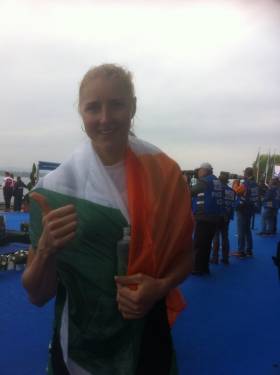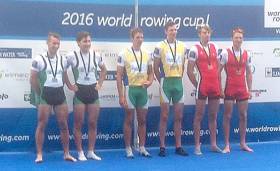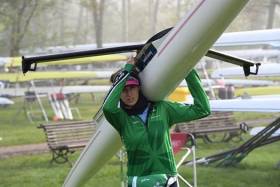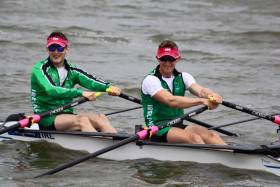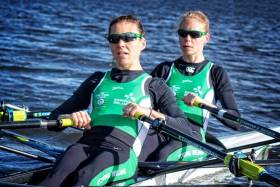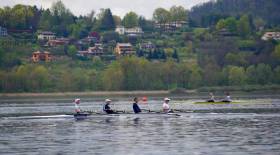Displaying items by tag: World Cup
#Rowing: Sinéad Lynch and Claire Lambe qualified for the semi-finals of the World Cup in Lucerne this morning with a fine performance in their heat. Drawn against World Champions Switzerland, Germany and Russia, and with just two places available, the Ireland lightweight double scull kept their heads and moved decisively in the third quarter to take the second spot behind winners New Zealand.
World Cup Regatta, Lucerne, Switzerland (Irish interest, selected results)
Women
Lightweight Double Sculls – Heats (Two to A/B Semi-Finals; rest to Repechage) – Heat One: 1 South Africa 6:57.90, 2 China Two 7:01.11. Heat Two: 1 Canada 6:56.56, 2 China One 6:57.98.
Heat Three: 1 New Zealand 7:00.16, 2 Ireland (C Lambe, S Lynch) 7:01.90; 3 Germany One 7:05.79, 4 Russia One 7:06.01, 5 Chile One.
Puspure Puts in Sprint Finish to Take Bronze in Varese
#Rowing: Sanita Puspure came from sixth to take the bronze medal at the World Cup Regatta in Varese. Carling Zeeman of Canada cut loose in the final quarter to win a surprise gold, with Ekaterina Karsten of Belarus holding off the fast-finishing Puspure to take silver.
World Cup Regatta, Varese, Italy – Day Three (Selected Results, Irish interest)
Men
Lightweight Double Sculls – A Final: 1 South Africa 6:41.13, 2 Ireland (G O’Donovan, P O’Donovan) 6:41.36, 3 Belgium 6:44.12; 4 Netherlands One 6:44.29, 5 Spain 6:49.1, 6 Denmark 6:55.17.
Women
Single Sculls – A Final: 1 Canada (C Zeeman) 7:49.41, 2 Belarus (E Karsten) 7:50.97, 3 Ireland (S Puspure) 7:51.40; 4 Switzerland 7:52.17, 5 Belarus Two 7:56.22, 6 China 7:57.53.
Brilliant Silver for Ireland's O'Donovan Brothers at World Cup
#Rowing: Ireland’s Gary and Paul O’Donovan took silver at the first World Cup Regatta of the year in Varese in Italy this morning. South Africa took gold, having broken away from the Irish in the final quarter, only to be almost caught on the line – thre was just .23 of a second in it. Belgium took the bronze.
World Cup Regatta, Varese, Italy – Day Three (Selected Results, Irish interest)
Men
Lightweight Double Sculls – A Final: 1 South Africa 6:41.13, 2 Ireland (G O’Donovan, P O’Donovan) 6:41.36, 3 Belgium 6:44.12; 4 Netherlands One 6:44.29, 5 Spain 6:49.1, 6 Denmark 6:55.17.
Walsh Wins B Final At World Cup Regatta
#Rowing: Denise Walsh won the B Final of the lightweight single sculls at the World Cup Regatta in Varese in Italy. The Skibbereen woman fought off Swiss and Algerian opponents to take seventh place overall at the event. Siobhán McCrohan, the second Ireland crew, withdrew.
World Cup Regatta, Varese – Day Two (Selected Results, Irish interest)
Men
Lightweight Four – C Final (places 13 to 16): 1 Canada One 6:09.73, 2 Serbia 6:11.21, 3 Austria 6:15.85, 4 Ireland (L Seaman, M O’Donovan, L Keane, S O’Driscoll) 6:16.00.
Lightweight Double Sculls – A/B Semi-Finals (First Three to A Final; rest to B Final) – Semi-Final One: 1 Ireland (P O’Donovan, G O’Donovan) 6:19.57, 2 Netherlands One 6:20.69, 3 Belgium One 6:20.85; 4 Poland One 6:22.21, 5 Switzerland One 6:24.99, 6 Portugal One 6:51.45. Semi-Final Two: 1 South Africa 6:19.42, 2 Spain 6:22.08, 3 Denmark 6:22.09; 4 Turkey 6:22.09.
Women
Pair – C Final (places 13 to 16): 1 Norway One 7:22.74, 2 Ukraine 7:23.16, 3 Ireland (L Kennedy, B O’Brien) 7:33.07.
Single Sculls – A/B Semi-Finals (First Three to A Final; rest to B Final) – Semi-Final One: 1 Ireland (S Puspure) 7:26.60, 2 Belarus Two (T Kukhta) 7:27.86, 3 Canada (C Zeeman) 7:29.01; 4 Ukraine 7:30.70, 5 Sweden 7:37.22, 6 Latvia 7:37.48. Semi-Final Two: 1 Belarus 7:29.10, 2 Switzerland 7:29.93, 3 China 7:31.28.
Lightweight Double Sculls – C Final (places 13 to 17): 1 Ireland (C Lambe, S Jennings) 7:17.24, 2 Italy Three 7:26.29, 3 Chile 7:29.71.
Lightweight Single Sculls – Repechage (First Two to A Final; rest to B Final): 1 Poland Two 7:49.90, 2 Switzerland One 7:51.76; 5 Ireland Two (S McCrohan) 8:04.69, 6 Ireland One (D Walsh) 8:08.81. B Final: 1 Ireland One (D Walsh) 7:50.00, 2 Switzerland 7:52.51, 3 Algeria 7:58.6.
O'Donovan Brothers Take Winning Route to A Final
#Rowing: Gary and Paul O’Donovan confidently took their place in the A Final of the lightweight double sculls at the World Cup regatta in Varese in Italy. The brothers from Skibbereen matched their winning performance in Friday’s heat, taking over the lead in the middle of the race and having over a second to spare over the second-placed Netherlands crew at the finish.
World Cup Regatta, Varese – Day Two (Selected Results, Irish interest)
Men
Lightweight Four – C Final (places 13 to 16): 1 Canada One 6:09.73, 2 Serbia 6:11.21, 3 Austria 6:15.85, 4 Ireland (L Seaman, M O’Donovan, L Keane, S O’Driscoll) 6:16.00.
Lightweight Double Sculls – A/B Semi-Finals (First Three to A Final; rest to B Final) – Semi-Final One: 1 Ireland (P O’Donovan, G O’Donovan) 6:19.57, 2 Netherlands One 6:20.69, 3 Belgium One 6:20.85; 4 Poland One 6:22.21, 5 Switzerland One 6:24.99, 6 Portugal One 6:51.45.
Women
Pair – C Final (places 13 to 16): 1 Norway One 7:22.74, 2 Ukraine 7:23.16, 3 Ireland (L Kennedy, B O’Brien) 7:33.07.
Single Sculls – A/B Semi-Finals (First Three to A Final; rest to B Final) – Semi-Final One: 1 Ireland (S Puspure) 7:26.60, 2 Belarus Two (T Kukhta) 7:27.86, 3 Canada (C Zeeman) 7:29.01; 4 Ukraine 7:30.70, 5 Sweden 7:37.22, 6 Latvia 7:37.48. Semi-Final Two: 1 Belarus 7:29.10, 2 Switzerland 7:29.93, 3 China 7:31.28.
Lightweight Double Sculls – C Final (places 13 to 17): 1 Ireland (C Lambe, S Jennings) 7:17.24, 2 Italy Three 7:26.29, 3 Chile 7:29.71.
Lightweight Single Sculls – Repechage (First Two to A Final; rest to B Final): 1 Poland Two 7:49.90, 2 Switzerland One 7:51.76; 5 Ireland Two (S McCrohan) 8:04.69, 6 Ireland One (D Walsh) 8:08.81
Puspure Takes Command and Wins Semi-Final
#Rowing: Sanita Puspure won her semi-final and will compete in the A Final of the single sculls at the World Cup Regatta in Varese in Italy. The Ireland sculler powered into an early lead and never relinquished it. A battle for second and third was won by Tatsiana Kukhta of Belarus and Carling Zeeman of Canada, with Ukraine’s Nataliya Dovgodko missing out and going to the B Final.
World Cup Regatta, Varese – Day Two (Selected Results, Irish interest)
Men
Lightweight Four – C Final (places 13 to 16): 1 Canada One 6:09.73, 2 Serbia 6:11.21, 3 Austria 6:15.85, 4 Ireland (L Seaman, M O’Donovan, L Keane, S O’Driscoll) 6:16.00.
Women
Pair – C Final (places 13 to 16): 1 Norway One 7:22.74, 2 Ukraine 7:23.16, 3 Ireland (L Kennedy, B O’Brien) 7:33.07.
Single Sculls – A/B Semi-Final One (First Three to A Final; rest to B Final): 1 Ireland (S Puspure) 7:26.60, 2 Belarus Two (T Kukhta) 7:27.86, 3 Canada (C Zeeman) 7:29.01; 4 Ukraine 7:30.70, 5 Sweden 7:37.22, 6 Latvia 7:37.48.
Lightweight Double Sculls – C Final (places 13 to 17): 1 Ireland (C Lambe, S Jennings) 7:17.24, 2 Italy Three 7:26.29, 3 Chile 7:29.71.
Lightweight Single Sculls – Repechage (First Two to A Final; rest to B Final): 1 Poland Two 7:49.90, 2 Switzerland One 7:51.76; 5 Ireland Two (S McCrohan) 8:04.69, 6 Ireland One (D Walsh) 8:08.81
Jennings and Lambe Win C Final at World Cup in Varese
#Rowing: Sinéad Jennings and Claire Lambe ended their campaign at the World Cup Regatta in Varese with a commanding performance to win the C Final of the lightweight double sculls. They led all the way and were four lengths clear of nearest rivals, Italy Three, at the finish.
Ireland had two competitors in the repechage of the women’s lightweight single sculls. There were two places on offer in an A Final, but Poland and Switzerland One took these. Siobhán McCrohan finished fifth and Denise Walsh sixth. In the lightweight men’s four, Ireland battled it out for third in the C Final with Austria, losing out by .15 of a second. In the C Final of the women’s pair, Leonora Kennedy and Barbara O’Brien finished third. Norway pipped Ukraine to win.
World Cup Regatta, Varese – Day Two (Selected Results, Irish interest)
Men
Lightweight Four – C Final (places 13 to 16): 1 Canada One 6:09.73, 2 Serbia 6:11.21, 3 Austria 6:15.85, 4 Ireland (L Seaman, M O’Donovan, L Keane, S O’Driscoll) 6:16.00.
Women
Pair – C Final (places 13 to 16): 1 Norway One 7:22.74, 2 Ukraine 7:23.16, 3 Ireland (L Kennedy, B O’Brien) 7:33.07.
Lightweight Double Sculls – C Final (places 13 to 17): 1 Ireland (C Lambe, S Jennings) 7:17.24, 2 Italy Three 7:26.29, 3 Chile 7:29.71.
Lightweight Single Sculls – Repechage (First Two to A Final; rest to B Final): 1 Poland Two 7:49.90, 2 Switzerland One 7:51.76; 5 Ireland Two (S McCrohan) 8:04.69, 6 Ireland One (D Walsh) 8:08.81
Jennings and Lambe Bound for C Final at World Cup
#Rowing: The Ireland lightweight double of Sinéad Jennings and Claire Lambe finished fourth in their repechage and are bound for a C Final of the World Cup in Varese in Italy. Italy One and Italy Two battled it out at the head of the field, while Ireland lost a battle for the third qualification spot to Sweden.
The Ireland men’s lightweight four finished fifth in their repechage, rowed as conditions became tougher. The Ireland women’s pair of Leonora Kennedy and Barbara O’Brien also finished fifth in their repechage and also go to a C Final.
World Cup Regatta, Varese (Selected Results, Irish interest)
Men
Lightweight Four – Heat Three (First Two to A/B Semi-Final; rest to Repechages): 1 Italy Two 6:00.40, 2 United States 6:00.95; 4 Ireland (L Seaman, M O’Donovan, L Keane, S O’Driscoll) 6:18.75. Repechage One (First Three to A/B Semi-Finals; rest to C Final): Poland One 6:01.07, 2 Japan One 6:02.92, 3 Poland Two 6:03.41; 5 Ireland 6:14.13.
Lightweight Double Sculls – Heat Three (First Two to A/B Semi-Final; rest to Repechages): 1 Ireland (P O’Donovan, G O’Donovan) 6:27.07, 2 Britain 6:33.38; 3 Netherlands Two 6:48.24.
Women
Pair – Heat One (First Two to A/B Semi-Final; rest to Repechages): 1 Germany 7:23.08, 2 Russia One 7:24.46; 5 Ireland (L Kennedy, B O’Brien) 7:46.38. Repechage Two (First Three to Repechages; rest to C Final): 5 Ireland 7:24.68.
Lightweight Double Sculls – Heat Two (First Two to A/B Semi-Final; rest to Repechages): 1 Switzerland 7:03.98, 2 Canada 7:04.45; 3 Ireland (C Lambe, S Jennings) 7:05.0. Repechage One (First Three to A/B Semi-Finals; rest to C Final): 1 Italy One 6:57.42, 2 Italy Two 6:59.61, 3 Sweden One 7:01.20; 4 Ireland 7:05.60.
Single Sculls – Heat One (Winner to A/B Semi-Finals; rest to Repechages): 1 Ireland (S Puspure) 7:34.32; 2 Czech Republic (M Knapkova) 7:36.13.
Lightweight Single Sculls – Heat One (First Two to A/B Semi-Final; rest to Repechages): 1 Netherlands Two 7:40.25, 2 Italy 7:45.99; 4 Ireland Two (S McCrohan) 8:02.38.
Heat Two (First Two to A/B Semi-Final; rest to Repechages): 1 Canada 7:42.41, 2 Netherlands One 7:45.30; 5 Ireland One (D Walsh) 8:11.91.
#Rowing: Ireland ended the first session of the World Cup in Varese with two heat wins and five crews set for the second chance of the repechages. Siobhan McCrohan finished fourth in her heat of the lightweight single sculls and Denise Walsh one place further back in her heat.
The men’s lightweight four finished fourth in their heat. The race was won by Italy Two, with the United States One second. Ireland placed fourth down the course, ahead of fifth-placed Austria One.
World Cup Regatta, Varese (Selected Results, Irish interest)
Men
Lightweight Four – Heat Three (First Two to A/B Semi-Final; rest to Repechages): 1 Italy Two 6:00.40, 2 United States 6:00.95; 4 Ireland (L Seaman, M O’Donovan, L Keane, S O’Driscoll) 6:18.75
Lightweight Double Sculls – Heat Three (First Two to A/B Semi-Final; rest to Repechages): 1 Ireland (P O’Donovan, G O’Donovan) 6:27.07, 2 Britain 6:33.38; 3 Netherlands Two 6:48.24.
Women
Pair – Heat One (First Two to A/B Semi-Final; rest to Repechages): 1 Germany 7:23.08, 2 Russia One 7:24.46; 5 Ireland (L Kennedy, B O’Brien) 7:46.38.
Lightweight Double Sculls – Heat Two (First Two to A/B Semi-Final; rest to Repechages): 1 Switzerland 7:03.98, 2 Canada 7:04.45; 3 Ireland (C Lambe, S Jennings) 7:05.0.
Single Sculls – Heat One (Winner to A/B Semi-Finals; rest to Repechages): 1 Ireland (S Puspure) 7:34.32; 2 Czech Republic (M Knapkova) 7:36.13.
Lightweight Single Sculls – Heat One (First Two to A/B Semi-Final; rest to Repechages): 1 Netherlands Two 7:40.25, 2 Italy 7:45.99; 4 Ireland Two (S McCrohan) 8:02.38.
Heat Two (First Two to A/B Semi-Final; rest to Repechages): 1 Canada 7:42.41, 2 Netherlands One 7:45.30; 5 Ireland One (D Walsh) 8:11.91.
O'Donovans Give Ireland Second Heat Win at World Cup Regatta
#Rowing: Ireland had its second heat win at the World Cup Regatta in Varese, as the lightweight double of Paul O’Donovan and Gary O’Donovan gave an excellent display. They took over the lead in the second half of the race and beat Britain into second place, with both crews qualifying for semi-finals.
Sinéad Jennings and Claire Lambe finished third in their heat, missing direct qualifcation for the semi-finals by just one spot. The Ireland lightweight double were very close to leaders Switzerland down the course, but in the drive for the line Canada took the second qualification place, with Ireland .55 of a second behind.
World Cup Regatta, Varese (Selected Results, Irish interest)
Men
Lightweight Double Sculls – Heat Three (First Two to A/B Semi-Final; rest to Repechages): 1 Ireland (P O’Donovan, G O’Donovan) 6:27.07, 2 Britain 6:33.38; 3 Netherlands Two 6:48.24.
Women
Pair – Heat One (First Two to A/B Semi-Final; rest to Repechages): 1 Germany 7:23.08, 2 Russia One 7:24.46; 5 Ireland (L Kennedy, B O’Brien) 7:46.38.
Lightweight Double Sculls – Heat Two (First Two to A/B Semi-Final; rest to Repechages): 1 Switzerland 7:03.98, 2 Canada 7:04.45; 3 Ireland (C Lambe, S Jennings) 7:05.0.
Single Sculls – Heat One (Winner to A/B Semi-Finals; rest to Repechages): 1 Ireland (S Puspure) 7:34.32; 2 Czech Republic (M Knapkova) 7:36.13.



























